During the annual conference in San Antonio, IRA announced the 2013 winners of the IRA Children’s and Young Adult Book Awards. This prestigious award focuses on promising debut authors; only first and second books by an author are considered. The award has a rich history of selecting authors whom become well-known names (Lois Lowry, Sy Montogomery, and Rebecca Stead, just to name a few), so check out the wonderful books below and watch for these new authors in the future.
Primary Fiction Winner:
Larson, Deborah Jo. (2012). One Frozen Lake. Illus by Steve Johnson and Lou Fancher. St. Paul, MN: Minnesota Historical Society Press.
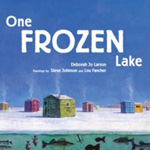 Larsen tells the touching story of a grandfather passing down the tradition of ice fishing with his grandson. Larson’s clever use of numbers and rhymes capture the immediate attention of young readers. As the fishing pair set up their gear inside the ice shack, they spend quality time together sorting tackle, drinking hot chocolate, playing cards, and making friends as they wait for that one big fish to bite. Finally… a bite, but the fish is too small, and grandfather advises his grandson to return him to the deep, dark waters underneath the thick ice. It appears that they are returning home empty-handed, but there is a stronger bond and a great memory of the day they went ice fishing together.
Larsen tells the touching story of a grandfather passing down the tradition of ice fishing with his grandson. Larson’s clever use of numbers and rhymes capture the immediate attention of young readers. As the fishing pair set up their gear inside the ice shack, they spend quality time together sorting tackle, drinking hot chocolate, playing cards, and making friends as they wait for that one big fish to bite. Finally… a bite, but the fish is too small, and grandfather advises his grandson to return him to the deep, dark waters underneath the thick ice. It appears that they are returning home empty-handed, but there is a stronger bond and a great memory of the day they went ice fishing together.
- Amy Vessel, Louisiana Tech University
Primary Fiction Honor:
Redmond, E.S. (2012). The Unruly Queen. Somerville, MA: Candlewick Press.
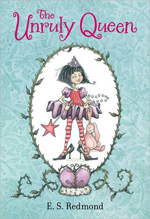 Minerva von Vyle is an impossible child! A spoiled rotten young girl left with house staff while the parents are always away, she stirs up a commotion each and every day. She commands and she demands. She refuses and she confuses. Her tantrums and fits make her seem impossible until the fifty-third nanny arrives. This nanny means business; Minerva has finally met her match! As the nanny crowns her the “Unruly Queen,” being bad doesn’t seem so wonderful anymore. We hope there is a sweet child underneath Minerva after all! E.S. Redmond’s use of vivaciously rich vocabulary with such rhythm and rhyme make this read aloud delightful to children of all ages.
Minerva von Vyle is an impossible child! A spoiled rotten young girl left with house staff while the parents are always away, she stirs up a commotion each and every day. She commands and she demands. She refuses and she confuses. Her tantrums and fits make her seem impossible until the fifty-third nanny arrives. This nanny means business; Minerva has finally met her match! As the nanny crowns her the “Unruly Queen,” being bad doesn’t seem so wonderful anymore. We hope there is a sweet child underneath Minerva after all! E.S. Redmond’s use of vivaciously rich vocabulary with such rhythm and rhyme make this read aloud delightful to children of all ages.
- Amy Vessel, Louisiana Tech University
Primary Nonfiction Winner:
McReynolds, Linda. (2012). Eight Days Gone. Illus. by Ryan O’Rourke. Watertown, MA: Charlesbridge.
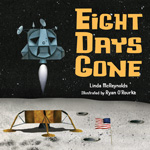 Linda McReynolds is …
Linda McReynolds is …
Rumbling. Blasting.
Seizing fame…
with her first book, Eight Days Gone. Through the use of simplistic, retro art work by Ryan O’Rourke and verse brimming with robust vocabulary, McReynolds leads young readers through the historic event of Apollo 11’s moon landing. With minimal words, she touches on the most memorable moments and key figures from the world’s first space adventure. Eight Days Gone is sure to send children on their own quest to discover the mysteries of the 1968 journey into the “starry darkness.”
- Kellie Kostrubala, Ward Central Elementary, Ward, AR
Primary Nonfiction Honor:
Hale, Christy. (2012). Dreaming Up: A Celebration of Building. New York: Lee & Low Books, Inc.
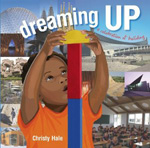 Stacking blocks, cereal, and toys around them encourages children’s fascination with building things. Dreaming Up: A Celebration of Building is an awesome resource connecting children’s imaginative play with that of architects across time and geography. The book links photographs of well-known buildings (on the right pages) with illustrations of basic creations by children (on the left pages.) Written in concrete poetry, the poems’ printed styles match the architectural styles of the buildings. This resourceful book encourages creativity in boys and girls, helping readers of all ages see endless possibilities. The additional information lends itself to further investigation of the architects and their buildings.
Stacking blocks, cereal, and toys around them encourages children’s fascination with building things. Dreaming Up: A Celebration of Building is an awesome resource connecting children’s imaginative play with that of architects across time and geography. The book links photographs of well-known buildings (on the right pages) with illustrations of basic creations by children (on the left pages.) Written in concrete poetry, the poems’ printed styles match the architectural styles of the buildings. This resourceful book encourages creativity in boys and girls, helping readers of all ages see endless possibilities. The additional information lends itself to further investigation of the architects and their buildings.
- Deb L. Marciano, Valdosta State University
Intermediate Fiction Winner:
Verrico, Susan. (2012). Privateer’s Apprentice. Atlanta, GA: Peachtree.
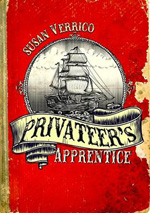 Susan Verrico’s debut novel, Privateer’s Apprentice, is a historical fiction treasure. Set in 1712 in the Carolina Territory, readers will be immediately drawn into the rich story world and become attached to its multi-dimensional characters. Jameson, the 13-year old son of a printer, has been recently orphaned, imprisoned, and sold into indentured servitude to the local baker. Just when he thinks his life could not get much worse, he is kidnapped by pirates and forced to live a life at sea. As Jameson proves his worth and finds his own place within the brigand of pirates, Verrico highlights the depth of humanity in her complex characters and reminds readers that one cannot judge people based on perceptions or first impressions.
Susan Verrico’s debut novel, Privateer’s Apprentice, is a historical fiction treasure. Set in 1712 in the Carolina Territory, readers will be immediately drawn into the rich story world and become attached to its multi-dimensional characters. Jameson, the 13-year old son of a printer, has been recently orphaned, imprisoned, and sold into indentured servitude to the local baker. Just when he thinks his life could not get much worse, he is kidnapped by pirates and forced to live a life at sea. As Jameson proves his worth and finds his own place within the brigand of pirates, Verrico highlights the depth of humanity in her complex characters and reminds readers that one cannot judge people based on perceptions or first impressions.
- Kara Coffino, University of Minnesota
Intermediate Fiction Honor:
Krumwiede, Lana. (2012). Freakling. Somerville, MA: Candlewick.
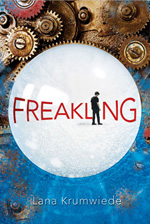 Freakling is often described as a dystopia novel for readers who are not quite ready for The Hunger Games. With twelve year old Taemon as the novel’s central character, Freakling is a perfect fit for readers age ten and up. Lana Krumwiede creates two worlds. In Deliverance, the members all have a power called psi – a form of telekinesis that allows them mentally to move and manipulate objects. This privileged society contrasts sharply with the other world called Powerless Colony. Taemon finds himself between two worlds when he loses one power and has to hide that fact; while he discovers another, he is not sure he wants to share. Freakling is the first of the Psi Trilogy and readers now can be quickly guided to Archon – the second book in the series.
Freakling is often described as a dystopia novel for readers who are not quite ready for The Hunger Games. With twelve year old Taemon as the novel’s central character, Freakling is a perfect fit for readers age ten and up. Lana Krumwiede creates two worlds. In Deliverance, the members all have a power called psi – a form of telekinesis that allows them mentally to move and manipulate objects. This privileged society contrasts sharply with the other world called Powerless Colony. Taemon finds himself between two worlds when he loses one power and has to hide that fact; while he discovers another, he is not sure he wants to share. Freakling is the first of the Psi Trilogy and readers now can be quickly guided to Archon – the second book in the series.
- Michael Ford, University of Wisconsin-Oshkosh
Intermediate Fiction Honor:
Lorenzi, Natalie Dias. (2012). Flying the Dragon. Watertown, MA: Charlesbridge.
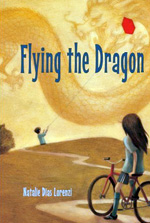 Natalie Dias Lorenzi’s Flying the Dragon is told from the points of view of the two co-protagonists, Skye (Sorano) and Hiroshi. Although they are first cousins, they meet for the first time when Hiroshi and his family move from Japan to Virginia so their grandfather can receive cancer treatment. American-born Skye knows little about her Japanese heritage and resents having to give up soccer in order to attend a language school on weekends so that she can communicate with her Japanese family. Hiroshi, who struggles to learn English and to fit in with his American classmates, finds great satisfaction in spending time with his beloved grandfather and flying their dragon kite. Both cousins resent each other and vie for their grandfather’s affections. Is it possible for them to ever find common ground?
Natalie Dias Lorenzi’s Flying the Dragon is told from the points of view of the two co-protagonists, Skye (Sorano) and Hiroshi. Although they are first cousins, they meet for the first time when Hiroshi and his family move from Japan to Virginia so their grandfather can receive cancer treatment. American-born Skye knows little about her Japanese heritage and resents having to give up soccer in order to attend a language school on weekends so that she can communicate with her Japanese family. Hiroshi, who struggles to learn English and to fit in with his American classmates, finds great satisfaction in spending time with his beloved grandfather and flying their dragon kite. Both cousins resent each other and vie for their grandfather’s affections. Is it possible for them to ever find common ground?
- Terrell A. Young, Brigham Young University
Intermediate Nonfiction Winner:
Doyle, James. (2012). A Young Scientist’s Guide to Defying Disasters With Skill and Daring. Illus. by Andrew Brozyna. Layton, UT: Gibbs Smith.
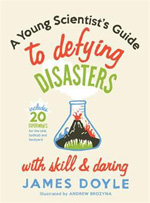 Interesting facts and survival tips for natural catastrophes, weather phenomena, and dreadful beasts that young scientists might encounter are presented in short chapters. A humorous undertone blends well with riveting details to make brief expository articles students will clamor to read. Between sections, experiments related to the topic are quickly explained. Each experiment could be easily conducted at home or school with everyday materials.
Interesting facts and survival tips for natural catastrophes, weather phenomena, and dreadful beasts that young scientists might encounter are presented in short chapters. A humorous undertone blends well with riveting details to make brief expository articles students will clamor to read. Between sections, experiments related to the topic are quickly explained. Each experiment could be easily conducted at home or school with everyday materials.
- Lauren Aimonette Liang, University of Utah
Young Adult Fiction Winner:
McNamara, Amy. (2012). Lovely, Dark and Deep. New York: Simon and Schuster.
 After a tragic car accident leaves her boyfriend dead and her world upside down, Wren retreats to the safety of her father’s home, secluded in the Maine woods. Seeking escape from overwhelming sadness and guilt, Wren isolates herself from everyone and everything, until she meets Cal Owen. Cal has his own issue, increasingly debilitating multiple sclerosis. At first, their connection is based upon their personal experiences with grief and loss. As time goes by, Wren must decide whether to remain imprisoned within her solitude or risk the vulnerability that accompanies building a relationship with Cal. McNamara paints an honest picture of the reality of bereavement through lyrical, poetic prose. Told in first person, one can’t help being drawn into Wren’s world, hopeful she will find a way out of her self-imposed prison, yet terrified if she tries. Beautifully written with well-developed characters and a compelling story, this novel is truly as its title describes: lovely, dark and deep.
After a tragic car accident leaves her boyfriend dead and her world upside down, Wren retreats to the safety of her father’s home, secluded in the Maine woods. Seeking escape from overwhelming sadness and guilt, Wren isolates herself from everyone and everything, until she meets Cal Owen. Cal has his own issue, increasingly debilitating multiple sclerosis. At first, their connection is based upon their personal experiences with grief and loss. As time goes by, Wren must decide whether to remain imprisoned within her solitude or risk the vulnerability that accompanies building a relationship with Cal. McNamara paints an honest picture of the reality of bereavement through lyrical, poetic prose. Told in first person, one can’t help being drawn into Wren’s world, hopeful she will find a way out of her self-imposed prison, yet terrified if she tries. Beautifully written with well-developed characters and a compelling story, this novel is truly as its title describes: lovely, dark and deep.
- Kelly Killorn, Minnesota State University- Mankato
Young Adult Fiction Honor:
Arcos, Carrie. (2012). Out of Reach. New York: Simon Pulse.
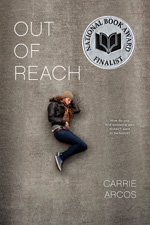 How do you save someone who doesn’t want to be saved? Rachel grapples with this question after she receives an anonymous email that her brother, Micah, is in trouble. Lost to the world of drug addiction, Micah has not responded to intervention attempts, and now he is living in the streets of Ocean Beach. Rachel and Tyler, Micah’s friend whom Rachel doesn’t entirely trust, decide to find him and bring him home, but their search yields no results. In the end, Rachel must learn to let go of her brother; but in her search for Micah, she has found a new friend.
How do you save someone who doesn’t want to be saved? Rachel grapples with this question after she receives an anonymous email that her brother, Micah, is in trouble. Lost to the world of drug addiction, Micah has not responded to intervention attempts, and now he is living in the streets of Ocean Beach. Rachel and Tyler, Micah’s friend whom Rachel doesn’t entirely trust, decide to find him and bring him home, but their search yields no results. In the end, Rachel must learn to let go of her brother; but in her search for Micah, she has found a new friend.
- Sue Corbin, Shaker Heights Middle School, Shaker Heights, Ohio
Young Adult Fiction Honor:
Kokie, E.M. (2012). Personal Effects. Somerville, MA: Candlewick.
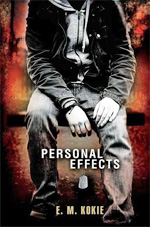 The search for a brother forms the heart E.M. Kokie’s realistic fiction novel Personal Effects. Seventeen year old Matt Foster goes on a journey to learn more about his brother TJ recently killed in Iraq. As he copes with grief, Matt grows frustrated by events at school and home. His questions about TJ intensify when he uncovers personal effects returned to the family after TJ’s death. Those clues lead Matt from Pennsylvania to Wisconsin where he finds another family obviously important in his brother’s life. The discovery forces Matt to look closely at his views of war and peace, racial and sexual identity, love and loss. This compelling character and his amazing journey will challenge readers and should provoke conversations about important contemporary issues.
The search for a brother forms the heart E.M. Kokie’s realistic fiction novel Personal Effects. Seventeen year old Matt Foster goes on a journey to learn more about his brother TJ recently killed in Iraq. As he copes with grief, Matt grows frustrated by events at school and home. His questions about TJ intensify when he uncovers personal effects returned to the family after TJ’s death. Those clues lead Matt from Pennsylvania to Wisconsin where he finds another family obviously important in his brother’s life. The discovery forces Matt to look closely at his views of war and peace, racial and sexual identity, love and loss. This compelling character and his amazing journey will challenge readers and should provoke conversations about important contemporary issues.
- Michael Ford, University of Wisconsin-Oshkosh
Young Adult Nonfiction Winner:
Levinson, Cynthia. (2012). We've Got a Job: The 1963 Birmingham Children’s March. Atlanta, GA: Peachtree.
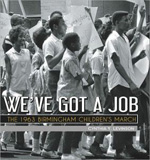 Audrey, James, Wash and Arnetta, alongside thousands of other young people, braved angry pedestrians, fire hoses, attack dogs, and even jail as they changed history marching for their freedom. Through their experiences, eyewitness accounts, and historical documents, Levinson weaves together the story of the 1963 Children’s March to end segregation in Birmingham, Alabama. Photographs bring faces to the participants and the opposition they encountered while textboxes and timelines help contextualize events surrounding the march. The book concludes with a map of routes taken by the marchers, an afterword with additional information about many of the children featured in the book, and a bibliography of nonfiction books, websites, and other texts for further study.
Audrey, James, Wash and Arnetta, alongside thousands of other young people, braved angry pedestrians, fire hoses, attack dogs, and even jail as they changed history marching for their freedom. Through their experiences, eyewitness accounts, and historical documents, Levinson weaves together the story of the 1963 Children’s March to end segregation in Birmingham, Alabama. Photographs bring faces to the participants and the opposition they encountered while textboxes and timelines help contextualize events surrounding the march. The book concludes with a map of routes taken by the marchers, an afterword with additional information about many of the children featured in the book, and a bibliography of nonfiction books, websites, and other texts for further study.
- Dawan Coombs, Brigham Young University
These reviews were submitted by members of the International Reading Association's 2012-13 Children’s and Young Adult Book Award Committee. More reviews of recent, outstanding children’s and young adult literature are published weekly on Reading Today Online by members of the Children's Literature and Reading Special Interest Group (CL/R SIG).